An abridged version of this article can be found at
https://www.moneycontrol.com/news/india/opinion-solar-alliance-can-match-opec-only-if-ground-rules-are-modified-3027551.html
Can the International Solar Alliance match OPEC?
RN Bhaskar — Oct 10, 2018
The occasion was the first assembly of the International Solar Alliance (ISA). The speaker was Prime Minister Narendra Modi, as 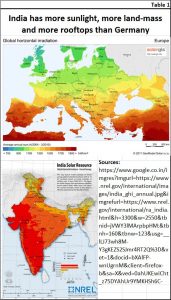 India is the place where the ISA has its office. Modi informed his audience that the ISA could take over as the dominant energy policy determining forum from the Organisation of Petroleum Exporting Countries (OPEC) in the future.
India is the place where the ISA has its office. Modi informed his audience that the ISA could take over as the dominant energy policy determining forum from the Organisation of Petroleum Exporting Countries (OPEC) in the future.
ISA was conceptualised by India and France during the COP-21 conference in 2015. And as Modi put it, “In the future, we must endeavour to ensure that there is One Sun, One World and One Grid. This will eliminate the energy poverty of the world as the sun is always shining somewhere.”
Added Sushma Swaraj, Minister for External Affairs, “India has extended a $1.4 billion credit-line in 27 countries for solar power generation projects.”
Modi may be right for three reasons. First, there is a disruption coming in the world of energy (see Tony Seba at https://www.youtube.com/watch?v=2b3ttqYDwF0). And the disrupting force could be solar. Second because India and China are likely to remain the biggest players in the solar energy field in the decades to come. Third, because India heads the ISA and therefore could have a strong voice in formulating its policies.
But there are challenges that ISA and India will have to confront.
First, the funds committed for the grand vision could be inadequate. ISA has often stated that the funds required would be close to US$ 1 trillion by 2030 for the massive deployment of solar energy. The 1.4 billion line of credit might be woefully inadequate. After all, ISA has 68 countries who have signed the ISA framework agreement (http://isolaralliance.org/MemberCont.aspx) Apart from these there are 60 other members making a total of 121 members to the alliance.
Second, India has begun emulating Germany, which was the world’s biggest champion for solar power (http://www.asiaconverge.com/2016/04/india-not-learn-germanys-hermann-scheer-solar-power-model/). But despite India’s advantages over Germany both in 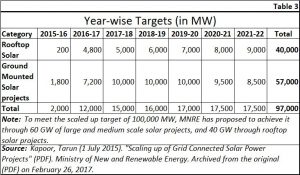 terms of solar footprint (see table 1) and solar potential (see table 2) , India still lags Germany’s installed capacity of 53GW (https://en.wikipedia.org/wiki/Solar_power_by_country). China leads with 131 GW of installed capacity compared with just 21.65 GW (see table 4). True, India’s solar targets may look impressive (see table 3), they still are small compared to some other global players.
terms of solar footprint (see table 1) and solar potential (see table 2) , India still lags Germany’s installed capacity of 53GW (https://en.wikipedia.org/wiki/Solar_power_by_country). China leads with 131 GW of installed capacity compared with just 21.65 GW (see table 4). True, India’s solar targets may look impressive (see table 3), they still are small compared to some other global players.
So even while Indians may believe that its solar march is impressive, it isn’t.
What is also embarrassing is that India will not be able to meet its target of 100 GW by 2021-22.
The way ahead
If India has to become a major force in the solar power space, it must first begin to de-regulate the power generation and power distribution sectors even further. True, the government has already decentralised power generation. There are more private power generators than there were say 20 years ago.
But power generators need markets, and so far the government is unwilling to allow generators to find their own customers. They must sell only to the grid, and it is the grid that then distributes the power through distribution companies or discoms. However, except for very few exceptions, almost all major power distributors are state owned companies.
And these discoms, because they want to play handmaiden to state governments allow power to be sold to the rural sectors and to needy people at highly discounted rates. The state does not reimburse the cost of these subsidies to discoms which tehn run into losses. Moreover, almost every discom runs into the problem of power theift which gets disguised through mis-declaration as electricity supply to agriculture (https://www.moneycontrol.com/news/news/business/economy/opinion-why-discom-losses-are-continuing-to-hurt-despite-modi-govts-uday-scheme-2974191.html).

Thus, even though India has managed to bring down the tariffs for solar power (see table 5), it has not been able to pass on this benefit to its consumers – both common households and to industry. Householders pay Rs.6-8 per unit of electricity. Business and industry pay Rs.8-14 per unit for their power needs.
As a result, power-intensive industries remain uncompetitive. Demand growth hasn’t taken off as needed, and private investment has been flagging.
In fact, India could easily manage to both augment solar power installed capacity as well as reduce the cost of power supply in India if it introduces two critically needed policy changes.
First, it must allow the private sector into distributed cluster power generation and distribution – with iron-clad guarantees that their investments will be protected. Thus power distribution to rural areas would come from local power generation units, both managed by private entrepreneurs, and not the government.
This would result in three things. First, it would allow hundreds of entrepreneurs to get into this sector. Second it would create around 80 million jobs within a couple of years. Third, it would accelerate entrepreneurship even among rural communities (http://www.moneycontrol.com/news/business/economy/will-lithium-become-the-new-bottleneck-2476297.html).
Together, all the three could make India both vibrant and a true leader of the ISA. Today, it has the trappings of a leader, with tremendous potential, but without the performance.





























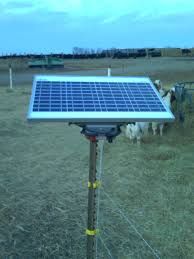
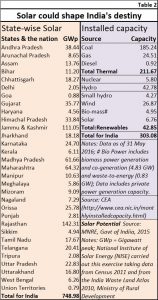












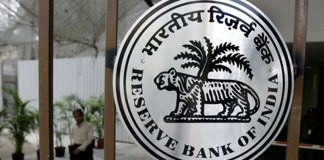
COMMENTS